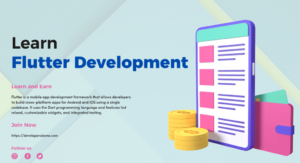Flutter’s Ripple Effect is an important aspect of the Flutter framework that enhances the user experience of any UI element in a Flutter app. This effect provides visual feedback to the user when they interact with a UI element, simulating the appearance of a ripple spreading out from the point of interaction. In this blog post, we’ll explore the ripple effect in detail, including how it works, its benefits for developers and users, and how you can implement it in your own Flutter app. Whether you’re new to Flutter or an experienced developer, understanding the ripple effect is essential for creating engaging and interactive user interfaces.
Contents
What is Flutter’s Ripple Effect?
Flutter’s ripple effect is a visual response that occurs when a user interacts with a UI element on the screen, such as by tapping a button or clicking on a link. This effect simulates the appearance of a ripple spreading out from the point of interaction, creating a dynamic and engaging visual effect. The ripple effect is an important aspect of the Flutter framework and is used extensively throughout Flutter apps to improve the user experience.
How Does Flutter’s Ripple Effect Work?
Flutter’s ripple effect works by creating a Material widget that overlays the UI element being interacted with. This Material widget is given a circular shape, and when the user interacts with the UI element, the Material widget expands outwards, creating a ripple effect that simulates the appearance of a wave spreading outwards.
The ripple effect is created using a combination of animation and rendering techniques. When the user interacts with the UI element, the Material widget is animated to expand outwards, and a mask is applied to create the circular shape of the ripple. The animation and rendering are handled by Flutter’s built-in animation framework, which ensures that the ripple effect is smooth and responsive.
What are the Benefits of FlutterRippleEffect?
Flutter’s ripple effect has a number of benefits for developers and users alike. From a developer’s perspective, the ripple effect is easy to implement and can be used to enhance the user experience of any UI element in a Flutter app. This makes it an important tool for creating engaging and interactive user interfaces.
From a user’s perspective, the ripple effect enhances the experience of interacting with UI elements by providing visual feedback that reinforces the user’s actions. This feedback creates a sense of responsiveness and interactivity that can make the app feel more engaging and enjoyable to use.
How Can You Implement FlutterRippleEffect?
Implementing Flutter’s ripple effect is relatively simple and can be done using the built-in Material widgets that are provided by the framework. To implement the ripple effect on a UI element, simply wrap the element in a Material widget and set the appropriate properties to control the appearance and behavior of the ripple effect.
For example, to implement the ripple effect on a button in a Flutter app, you would use the following code:
MaterialButton(
onPressed: () {
// Handle button press
},
child: Text('Click me!'),
)
This code creates a MaterialButton widget and sets an onPressed callback to handle the button press. When the user presses the button, the MaterialButton widget will display a ripple effect that simulates a wave spreading outwards from the point of interaction.
Conclusion
Flutter’s ripple effect is a powerful tool for enhancing the user experience of any Flutter app. By providing visual feedback that reinforces the user’s actions, the ripple effect creates a sense of responsiveness and interactivity that can make the app feel more engaging and enjoyable to use. If you’re developing a Flutter app, be sure to take advantage of the ripple effect to create a dynamic and engaging user interface. Overall, Flutter’s Ripple Effect is an essential tool for creating a seamless and interactive user interface in your Flutter app.


